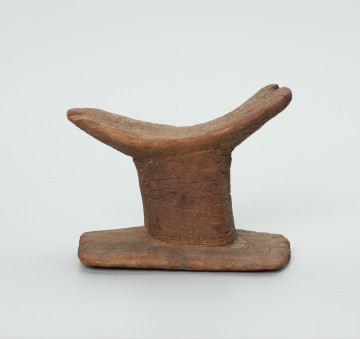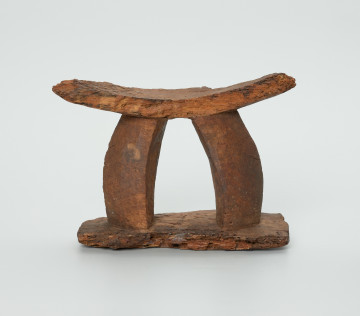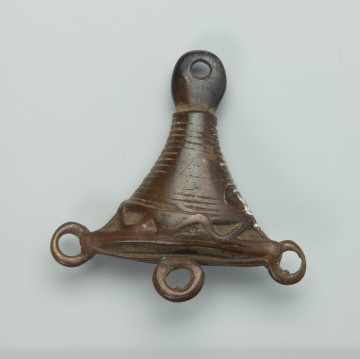
Headrest
między 1001 — 1300
National Museum in Szczecin
Part of the collection: Collection of Dogonian art
The presented bolster was used by the Tellem, the indigenous people inhabiting the Bandiagara Escarpment before the arrival of the Dogon. It was used for resting and sleeping - the back of the head or the neck was placed on the upper part of the bolster, which resembled a flat, wooden crescent - and in burial rites. Archaeological research carried out in the 1960s by Rogier M. A. Bedaux, a Dutch archaeologist, inside the cliffs of Bandiagara illustrates the relatively rich burial customs of the Tellem. They wrapped their dead in cloth and buried them in caves located in the rocks. Specially prepared caves were closed with a clay wall. Men and women were buried in the same cave. Numerous gifts were deposited next to their bodies - some for women (including fibre ornaments, small baskets and bolsters) and some for men (including bows, quivers, arrows, bolsters, animal skulls and hoe handles). Objects found with the dead related to their daily activities. Hoe handles were deposited with the farmer, and bows, arrows and quivers with the hunter. Children were probably buried separately - unfortunately, archaeologists have not been able to confirm this. The remains were found in a crouched or lying position. Bolsters were only found in a few burial caves. Thanks to the research with radioactive carbon C14, it was possible to establish that in the 11th-13th century, the Tellem people used wooden bolsters. In contrast, from the 14th century, with the development of smithery, they also started to produce iron bolsters. All objects made of wood, cotton, wool and leather found in Tellem caves are among the oldest in West Africa. However, the bolsters in the collection of the National Museum in Szczecin are the first objects of this type in Polish museums.
Katarzyna Findlik-Gawron
Author / creator
Dimensions
cały obiekt: height: 13,1 cm, width: 16,9 cm
Object type
bolster
Creation time / dating
Creation / finding place
Identification number
Location / status

między 1001 — 1300
National Museum in Szczecin

między 1001 — 1300
National Museum in Szczecin

między 1201 — 1500
National Museum in Szczecin
DISCOVER this TOPIC
Museum of King Jan III's Palace at Wilanów
DISCOVER this PATH
Educational path